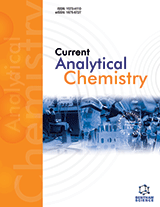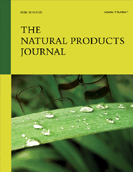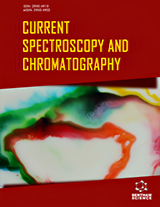Abstract
Background: A new modified electrode based on the poly(chromotropic acid) (4,5-dihydroxynaphthalene- 2,7-disulfonic acid) film was developed by electrochemical polymerization to explore its voltammetric behavior. The electrochemical synthesis of poly(chromotropic acid) was accomplished by applying an aqueous solution of sodium hydroxide as a supporting electrolyte (0.1 M). The electrochemical behaviors of bisphenol A (BPA) on poly(chromotropic acid) modified glassy carbon electrode (poly(CTA)/GCE) were researched by cyclic voltammetry, square wave voltammetry, and chronoamperometry.
Methods: The analytical performances of the developed method were carefully examined. When the concentration of BPA changed from 0.1 µM to 20 µM, the current response of BPA was linearly related to the concentration over the range of 0.1–2 µM and 2.0–20 µM, respectively and the detection limit of the suggested method was found to be 0.06 µM. The feasibility of the detector was successfully demonstrated for BPA detection in various real samples.
Results: The suggested methodology was applied for the detection of BPA in different real samples (bottled water, tap water and honey sample). The samples were prepared as described above and these aforesaid samples were analyzed directly. Since no BPA was detected in these samples, standard addition method was employed. The percent recovery tests were also investigated by measuring the current responses to the samples in which the known concentrations of BPA standard solution were spiked. Thus, the spikes are subjected to similar matrix effects. The percent recoveries in the range of 94.0%– 103% were obtained. These consequences indicated that the poly(CTA)/GCE has adequate electroanalytical efficiency and it can be a feasible sensor for detection of BPA in different samples.
Conclusion: A new voltammetric sensor for the detection of BPA was developed based on a very simple preparation scheme consisting in the direct electropolymerization of poly(CTA) films on GCE. The proposed poly(CTA)/GCE displays a helpful and easy method for observing of BPA in real aqueous samples exhibiting an adequate electroanalytical performance (linearity, detection limit, sensitivity, and selectivity) due to its stability and reproducibility associated with an effortless and speedy fabrication, and low cost. This new method could offer a charming approach for on-site detection of trace BPA contamination in aqueous samples.
Keywords: Bisphenol A, determination, voltammetry, chromotropic acid, food analysis, water analysis.
Graphical Abstract
Current Analytical Chemistry
Title:Electrochemical Determination of Bisphenol A Based on Poly(Chromotropic Acid) Modified Glassy Carbon Electrode
Volume: 13 Issue: 6
Author(s): Hayati Filik*Asiye Aslihan Avan
Affiliation:
- Istanbul University, Faculty of Engineering, Department of Chemistry, 34320 Avcilar, Istanbul,Turkey
Keywords: Bisphenol A, determination, voltammetry, chromotropic acid, food analysis, water analysis.
Abstract: Background: A new modified electrode based on the poly(chromotropic acid) (4,5-dihydroxynaphthalene- 2,7-disulfonic acid) film was developed by electrochemical polymerization to explore its voltammetric behavior. The electrochemical synthesis of poly(chromotropic acid) was accomplished by applying an aqueous solution of sodium hydroxide as a supporting electrolyte (0.1 M). The electrochemical behaviors of bisphenol A (BPA) on poly(chromotropic acid) modified glassy carbon electrode (poly(CTA)/GCE) were researched by cyclic voltammetry, square wave voltammetry, and chronoamperometry.
Methods: The analytical performances of the developed method were carefully examined. When the concentration of BPA changed from 0.1 µM to 20 µM, the current response of BPA was linearly related to the concentration over the range of 0.1–2 µM and 2.0–20 µM, respectively and the detection limit of the suggested method was found to be 0.06 µM. The feasibility of the detector was successfully demonstrated for BPA detection in various real samples.
Results: The suggested methodology was applied for the detection of BPA in different real samples (bottled water, tap water and honey sample). The samples were prepared as described above and these aforesaid samples were analyzed directly. Since no BPA was detected in these samples, standard addition method was employed. The percent recovery tests were also investigated by measuring the current responses to the samples in which the known concentrations of BPA standard solution were spiked. Thus, the spikes are subjected to similar matrix effects. The percent recoveries in the range of 94.0%– 103% were obtained. These consequences indicated that the poly(CTA)/GCE has adequate electroanalytical efficiency and it can be a feasible sensor for detection of BPA in different samples.
Conclusion: A new voltammetric sensor for the detection of BPA was developed based on a very simple preparation scheme consisting in the direct electropolymerization of poly(CTA) films on GCE. The proposed poly(CTA)/GCE displays a helpful and easy method for observing of BPA in real aqueous samples exhibiting an adequate electroanalytical performance (linearity, detection limit, sensitivity, and selectivity) due to its stability and reproducibility associated with an effortless and speedy fabrication, and low cost. This new method could offer a charming approach for on-site detection of trace BPA contamination in aqueous samples.
Export Options
About this article
Cite this article as:
Filik Hayati*, Avan Aslihan Asiye, Electrochemical Determination of Bisphenol A Based on Poly(Chromotropic Acid) Modified Glassy Carbon Electrode, Current Analytical Chemistry 2017; 13 (6) . https://dx.doi.org/10.2174/1573411013666161214112952
| DOI https://dx.doi.org/10.2174/1573411013666161214112952 |
Print ISSN 1573-4110 |
| Publisher Name Bentham Science Publisher |
Online ISSN 1875-6727 |
 22
22 1
1
- Author Guidelines
- Bentham Author Support Services (BASS)
- Graphical Abstracts
- Fabricating and Stating False Information
- Research Misconduct
- Post Publication Discussions and Corrections
- Publishing Ethics and Rectitude
- Increase Visibility of Your Article
- Archiving Policies
- Peer Review Workflow
- Order Your Article Before Print
- Promote Your Article
- Manuscript Transfer Facility
- Editorial Policies
- Allegations from Whistleblowers
- Announcements
Related Articles
-
The “Invisible Proteome”: How to Capture the Low-Abundance Proteins Via Combinatorial Ligand Libraries
Current Proteomics Multimodality Imaging of CXCR4 in Cancer: Current Status towards Clinical Translation
Current Molecular Medicine Post-Exercise Ketosis, Salivary Uric Acid and Interleukin-6 after a Simulated Wheelchair Basketball Match
Endocrine, Metabolic & Immune Disorders - Drug Targets An Integrated Platform for Bio-Analysis and Drug Delivery
Current Pharmaceutical Biotechnology Using Pseudo Amino Acid Composition to Predict Protein Attributes Via Cellular Automata and Other Approaches
Current Bioinformatics Tackling Chronic Pain and Inflammation through the Purinergic System
Current Medicinal Chemistry An Up-date of Olive Oil Phenols in Inflammation and Cancer: Molecular Mechanisms and Clinical Implications
Current Medicinal Chemistry Metal-dithiocarbamate complexes: chemistry and biological activity
Mini-Reviews in Medicinal Chemistry Repurposing of Anticancer Drugs for the Treatment of Bacterial Infections
Current Topics in Medicinal Chemistry Patent Perspective for Potential Antioxidant Compounds-Rutin and Quercetin
Recent Patents on Nanomedicine Total Synthesis and Bioactivity of ent-homospisulosine and N,O-diacetylhomoclavaminol A
Current Organic Chemistry Nitric Oxide: State of the Art in Drug Design
Current Medicinal Chemistry Mutation Studies in the Active Site of β-glycosidase from Pyrococcus furiosus DSM 3638
Protein & Peptide Letters Electrochemical Cell-based Biosensors for Biomedical Applications
Current Topics in Medicinal Chemistry In-Vitro CYP3A4, CYP2E1 and UGT Activity in Human Liver Microsomes by Strobilanthes crispus Leaf Extracts
The Natural Products Journal Matrix Metalloproteinases as Drug Targets in Preeclampsia
Current Drug Targets Four Major Factors Regulate Phosphatidylinositol 3-kinase Signaling Pathway in Cancers Induced by Infection of Human Papillomaviruses
Current Medicinal Chemistry Quality Control of Fingerprint of Radix Astragali by High-Performance Liquid Chromatography Coupled with Chemometric Methods
Current Pharmaceutical Analysis Monosaccharide Compositional Analysis of Glycoproteins Using Liquid Chromatography-Mass Spectrometry
Current Proteomics Effect of Drugs in Cells and Tissues by NMR Spectroscopy
Current Topics in Medicinal Chemistry


























